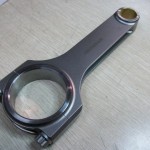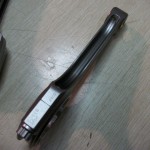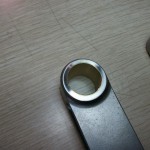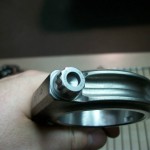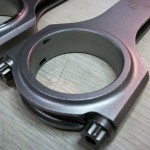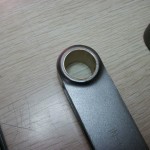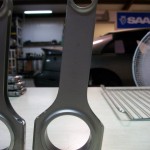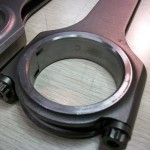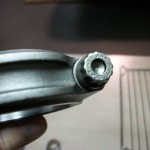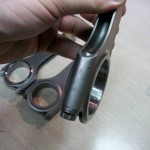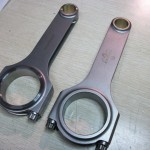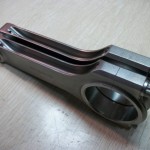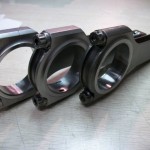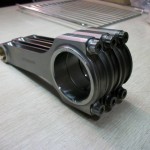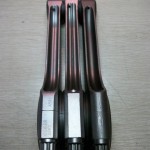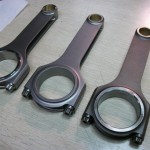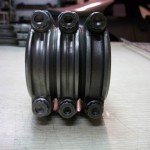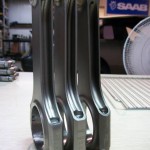My last comparison that was written, showcased two of the most common pistons we use in the VG30 build scene. While I’ve gotten a lot of questions and seen a lot of statements based off the comparison article I wrote, I still want to reiterate the importance of quality. If you remember in my article I made mention that there is no better piston over another yet differences that set each apart. Today I’m going to discuss the differences between the 3 H-Beam rods we have on the market that are most widely used. Like the pistons, I will have some detailed images for you to view the different details.
So lets start with the Carillo H-Beam rod. I have to say out of all the finishes (final product) the Carrillo is hands down the top choice. Just the physical tangible feel of the rod trumps the finishes that both Eagle and SCAT rods possess. But don’t let that be the only and deciding factor. While Carrillo has the best finish they lack in affordability. At $1600+ they are 2 to 3 times as expensive as their counterpart. But lets take a look at why they are priced as they are. Here is Carrillos specifications on their connecting rod manufacturing process.
Carrillo uses proprietary chrome, nickel, moly, vanadium alloy which meets all VAR (vacuum arc re-melt ASTM standards). The heat is validated, both by the supplier and an independent metallurgist whom confirm the desired physical and chemical properties of steel.
All heat treat processes are via a mar-aged operation, resulting in UTS of 195,000 with a yield of 182,000 while maintaining the critical elements of low notch-sensitivity and ductility.
All Carrillo connecting rods are manufactured from an oversized forging resulting in the proper grainflow as well as the surface removal of any potential inclusions or surface conversions generated by the forging process. All critical CNC machines at Carrillo are equipped with probing to accurately validate dimensional integrity. In the production process each part is magnafluxed at least twice, further each piece is Rockwell tested to validate the heat treat procedure. A final shotpeen operation completes the part.
Carrillo employs fasteners jointly designed by Carrillo. We employ two different materials: H-11 tool steel (220,000 UTS) as well as Multiphase TM (285,000 UTS). All our fasteners employ a patented thread design as well as the highest dimensional integrity in the industry. Each lot is sample tested destructively for both ultimate tensile strength as well as fatigue.
The CARRILLO connecting rod is a precision, high strength, quality connecting rod, which when properly installed and maintained, will perform flawlessly in today’s racing and high performance internal combustion engines. We would like to offer some suggestions and specifications that should be helpful in your installation.
Lots going on there as you can see. Industries leading procedures and attention to detail give you a product that is without a doubt a top shelf quality product. Carrillo offers a plethra of options that customers can choose to have incorporated into their rods if they so choose to. Options go from annular grooves, lipped cap and cap reliefs, thrust face grooves and so forth. They really do take a special interest in details which seem to work very well in their lineup of connecting rod products. But lets look at the nitty gritty for the VG30
Features:
Bronze bushing for wrist pin (floating pin bore design)
Proprietary material (alloy) design
Machined Big End thrust faces
Machined Pin Bore thrust faces
Twin Oil return from pin bore
Carr 3/8 bolts
Doweled Caps
Super finishing process
Weight is approx 560g to 570g
Next up is Eagle connecting rods. This particular connecting has been in use for several years in the Z32 community. A few good reasons, partly due to availability, price, and more individuals in the community have utilized the Eagle brand more so than any other offering for the VG3o platform. Priced substantially cheaper than the Carrillo it does share some of the same and similar traits as the Carrillo. Finishing isn’t as good but keep in mind this is more of a budget oriented connecting rod but don’t let that fool you into thinking that it isn’t strong and built tough enough to handle some serious abuse. My personal/professional view on Eagle rods is that they could improve on some key areas but for the most part you get a solid quality product for the value you are spending. So whats good about Eagle? Well quite simply its an H-beam rod…just like the Carrillo its the toughest design on the market so you get piece of mind in knowing you have a quality design. The downfall I see with Eagle from experience with material handling of different components is that Eagle lacks a few details that to me should be addressed. Pin bore thrust faces are machined but done poorly compared to the other variants. This detail makes the rod appear cheap in quality. The same goes for the thrust faces on the big end of the rod. The shot peen process is very rough but a shot peen surface does prove beneficial but it must also feel/look good as well. You have to remember ppl are very visual and hands on so if it doesn’t look good or feel good most would pass on the product. Many not having the luxury of being able to feel the differences between the various connecting rods are left in the dark. This is where articles like this showcase differences to educate you as the consumer/customer.
Features:
4340 Forging
ARP 2000 3/8 Rod bolts
Bronze bushing for wrist pin (floating pin bore design)
Twin Oil return from pin bore
Doweled caps
The last connecting rod I am putting up on the table is made by SCAT. My absolute favorite budget connecting rod for a Z32. I’ve used these in countless engine assemblies all boasting over 800rwhp with absolutely NO ISSUES! SCAT uses the same forgings as Eagle but are handled and processed a little differently. I’m very partial to SCAT because they offer a product dead in the middle with quality, price, and availability. For one thing since most are price driven, you can afford to shell out $475 for a set of SCAT rods. Eagles typically go for $550-$600. So there alone you are already more apt to choose this brand. Looking over the machining details between Eagle and SCAT, the SCAT variant is absolutely a better machined product. Finish is better, tolerances that I’ve seen and come across are more precise and they utilize all the same features/functions as the other two rods displayed above. So what is the main point of why I like the SCAT over Eagle, well besides the few attributes I stated above, SCAT keeps things very simple. So that does help with costs. I like the fact they maintain the big end profile with a radius end cap. This gives it a much more robust figure there being it can stand up to some heavy abuse.
Features:
4340 Forging
ARP 2000 3/8 Rod bolts
Machined thrust faces on small & big end of rods are more precise
Bronze bushing for wrist pin (floating pin bore design)
Twin Oil return from pin bore
Doweled caps
Large radius big ends for added support and strength
Final finish practices better than other budget rod in comparison
Compared to Carrillo, SCAT would be my second choice (keeping the mindset that we are ONLY shopping H-Beam rods) So here is a break down on which one to choose based on a few elements. Keep in mind this is MY view point and others can form their own opinion but from my experience this is how I view the items and make my educated decision.
If price wasn’t an issue and you are willing to spend the money:
- Carrillo
- SCAT
- Eagle
If you are looking for highest quality:
- Carrillo
- SCAT
- Eagle
If you are looking for a budget rod that offers the best bang for the buck:
- SCAT
- Eagle
- Carrillo
If you are looking for the best all around rod for quality, price, & availability:
- SCAT
- Carrillo
- Eagle
So what does that tell you?
Though I don’t want ppl to discredit Eagle rods, I also want ppl to know that there are other choices out there that are better for far less and some extremely better if you’re willing to open the wallet up some. I hope you’ve had some new light shed on the components used day in and day out in the Z32 scene that contribute to so many builds on the market. It really is important that you the customer know these differences and can tell them apart from each other. Its you who are spending the money and I really want you all be fully aware and educated on the process and quality that each component has. Remember there is no better component…its merely a list of specifications that set them apart from each other. Choose wisely and always think with your head and never your wallet. You will be surprised at the things you find when you buy quality.
Below are images of all three connecting rods shown together so you can get a birds eye view on the differences side by side.


